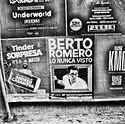....Jeff....
Member
- Joined
- Jun 1, 2011
- Messages
- 14
- Format
- 35mm
Hello Everyone,
As I am trying to work through some issues with plating/bronzing in the margins of my pure palladium prints, one common theme I keep coming across is the importance of sufficient absorption of the sensitizer into the paper. Printers seem to tackle this issue in two different ways (or some combination there of), Tween in the sensitizer and humidification. What I gather from the research I've done so far is that both methods are supposed to have essentially the same end result, increased penetration of the sensitizer into the fibers of the paper. With humidification, the increased moisture content of the paper is said to facilitate the coating being wicked deeper into the paper fibers than it otherwise would be at a lower relative humidity. Tween, being a surfactant, reduces the surface tension of the sensitizer allowing it to penetrate more readily into the the paper fibers.
My question, is it necessary to use both Tween and humidification to help mitigate issues such as solarization and to punch up Dmax, or is strict control over humidification alone sufficient? Specifically, I am considering doing some testing where I will be humidifying paper to 70-75% prior to coating and prior to exposure and wondering if there is any added benefit to using Tween at this humidity. Or worse, if it will cause excessive absorption and the unnecessary need for increased sensitizer. I'd be interested in hearing feedback on your respective experiences when it comes to balancing these two variables and your opinions on their necessity or redundancy.
Thanks,
Jeff
As I am trying to work through some issues with plating/bronzing in the margins of my pure palladium prints, one common theme I keep coming across is the importance of sufficient absorption of the sensitizer into the paper. Printers seem to tackle this issue in two different ways (or some combination there of), Tween in the sensitizer and humidification. What I gather from the research I've done so far is that both methods are supposed to have essentially the same end result, increased penetration of the sensitizer into the fibers of the paper. With humidification, the increased moisture content of the paper is said to facilitate the coating being wicked deeper into the paper fibers than it otherwise would be at a lower relative humidity. Tween, being a surfactant, reduces the surface tension of the sensitizer allowing it to penetrate more readily into the the paper fibers.
My question, is it necessary to use both Tween and humidification to help mitigate issues such as solarization and to punch up Dmax, or is strict control over humidification alone sufficient? Specifically, I am considering doing some testing where I will be humidifying paper to 70-75% prior to coating and prior to exposure and wondering if there is any added benefit to using Tween at this humidity. Or worse, if it will cause excessive absorption and the unnecessary need for increased sensitizer. I'd be interested in hearing feedback on your respective experiences when it comes to balancing these two variables and your opinions on their necessity or redundancy.
Thanks,
Jeff





